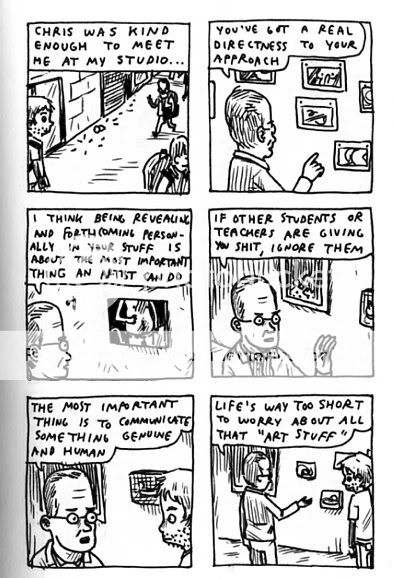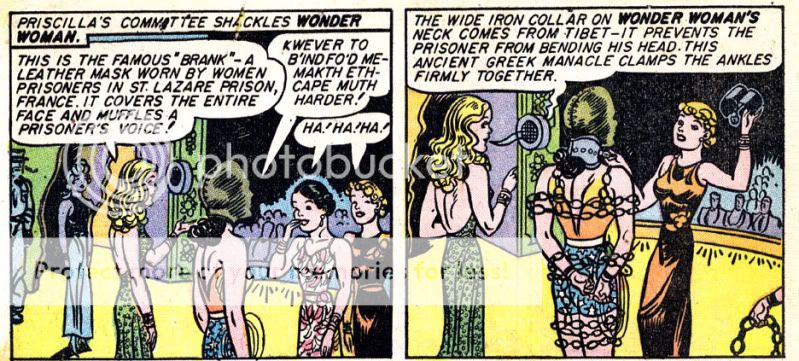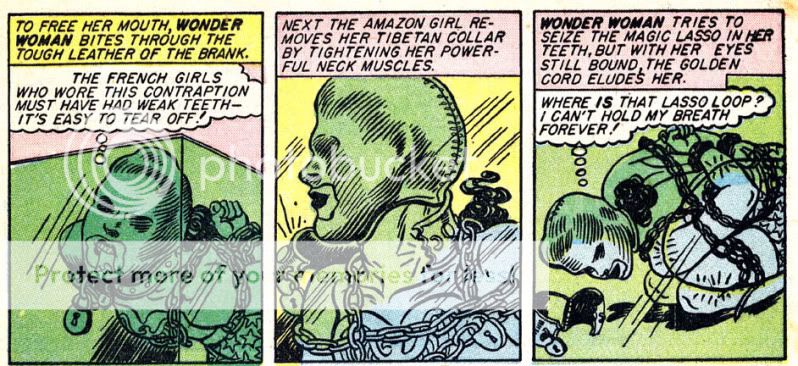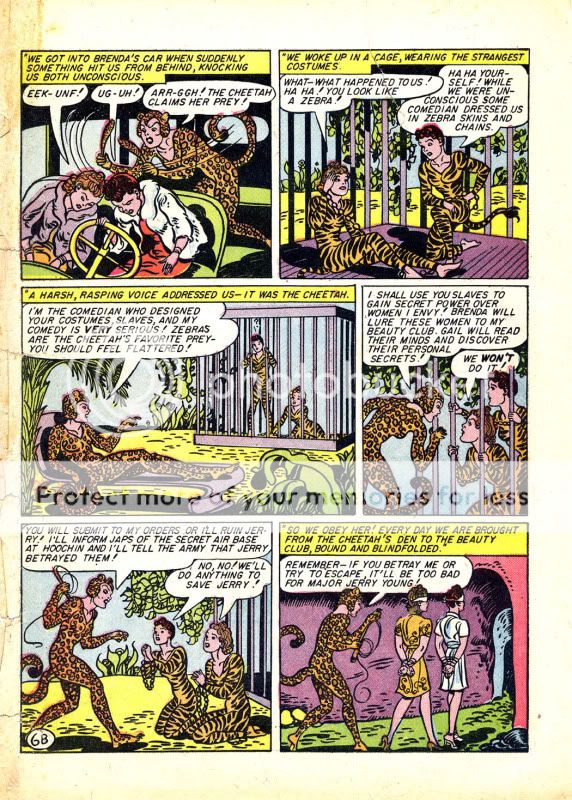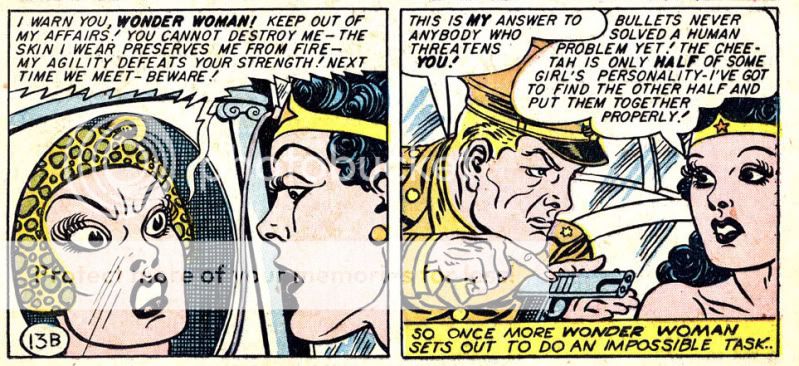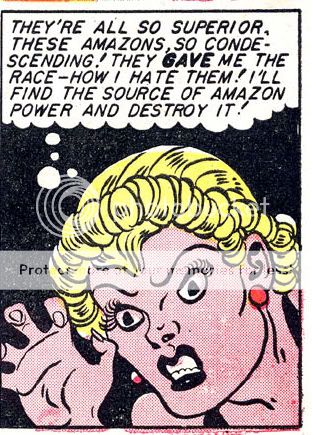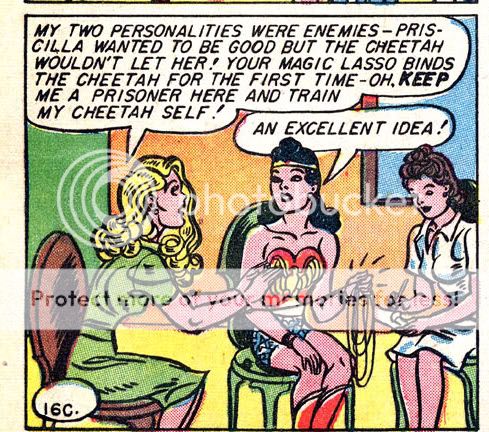I finally read the first collection of Gail Simone Wonder Woman comics, (“The Circle”). It’s definitely an interesting take on the character. In fact, among post-Marston creators, Simone is, I think, alone in avoiding the pratfalls which have plagued virtually every creator who has tackled WW after Marston. (Unless you want to count Alan Moore’s Glory.)
So how does Simone manage not to be tripped up by the bondage lasso, or the incredibly poorly defined mission to man’s world, or any number of other traps Marston has set for his unwary followers? Well, she does it primarily by writing fan fiction, and by treating WW as a Mary Sue — a character who the author loves too much. Fantasy author Mercedes Lackey says as much in the introduction to the volume, where she starts out by saying that she never liked Wonder Woman the character, and then goes on to praise Simone for creating a Wonder Woman that she (Lackey) could love. The ultimate standard, in other words, is not craft, or thoughtfulness, or originality, but loveability. Lackey wants a Mary Sue, and Simone delivers.
“Mary Sue” is usually a term applied to fan-fiction characters, where it tends to be seen as as a deadly insult. And there are many manifestations of it which are certainly unpleasant. I talked in an earlier post, for example, about the way in which League of One is basically all Mary Sue fanscruff pander, reveling in WW’s strength and purity and general awesomeness until you just wish she’d die tragically and beautifully already and get it over with. And there’s definitely more than a touch of that in Simone’s version too, with everyone and their aunt racing to tell WW how mega-awesome she is. Super-intelligent gorilla warriors fall on their knees before her; intergalactic genocidal Khund warriors build statues in her honor all over their planet. And while I don’t need WW to whine as much as Spider-Man or (god forbid) Greg Rucka’s version of the character does, it would have been nice to see Simone give the sainted Diana a self-doubt once or twice in the volume (and no, accepting your inevitable death without blinking doesn’t count as a self-doubt.)
Still, the truth is that WW was more or less intended as a Mary Sue to begin with. Marston loved her (even arguably overmuch) and he created her more or less to be loved by his readers — girls and boys alike. Nor was Marston’s version especially given to self-doubt (though unwavering confidence is a lot less irritating when you’re not subjected to it in internal monologues.)
So there’s a sense in which Simone’s Mary Sue pandering — her transparent puffery of the character — is very much in the spirit of the original. And Simone’s love of the character allows her to deal with the character’s structural problems as any good fan-fiction writer would — by reducing them to fan in-jokes. WW’s embarrassing bondage heritage is mentioned in passing by a callow Nazi, who cracks wise about wanting her to tie him up in her magic lasso. Then WW swoops in and threatens him with the real Lasso of Truth and he goes all weak-kneed like a baby man. The unfortunate sartorial choices Marston bequeathed are similarly deflated; there’s a really cute moment where an admiring onlooker mentions “I just want to say as a gay man that I miss the high heels on your boots…” The lesbian implications of Paradise Island get similarly defused in a joking aside (WW’s love-interest notes that courtship on Paradise Island must be between women, and WW responds “Aren’t you the observant one.”)
The humor in the book is probably the best thing about it — and the best moments of humor are those in which WW is most like a Mary Sue. Which is to say, since Mary Sue is often thought of as being an author surrogate, the high points of the book are those in which WW and Gail Simone seem closest to one another. My single favorite line in the comic comes when Diana Prince is having a birthday party at work. She’s musing about the fact that hugging her coworkers in gratitude for the surprise party would be frowned upon, and she thinks: “It is a strange culture that outlaws the hug. On the other hand…there is cake, and that excuses much.” Another gem is when WW looks at the statues the Khund have erected to her…which attempt to honor her by depicting her as a brutish looking Khund. WW looks at them, and then thinks to herself that she wants to call a friend (Donna Troy, I think) on her cell phone because she’d be really amused.
In some alternate timeline, perhaps, there’s a perfect Gail Simone fan-fic Wonder Woman, which is entirely composed of such moments — all romantic comedy banter, goofy relationship moments, and slice-of-life silliness, with the super-heroics mentioned occasionally in passing but never allowed to interfere with the real focus. Unfortunately, in the more hum-drum world we inhabit, Simone is writing a corporate comic, and there are certain hoops she’s got to jump through to get her paycheck. She has to, for example, make her story a comic, which means she needs art. And so we’ve got drawings by a number of pencillers (Terry Dodson and Bernard Chang predominantly). As mainstream illustrators go, neither is horrible. But just because they don’t make me want to gouge my eyes out doesn’t mean that they actually add anything of value to the story.
Simone also needs DCU continuity porn, and she needs pulp action. She provides the first of these eagerly enough, and with some panache. Sure, the level of background knowledge needed to follow the story is pretty much ridiculous; I was occasionally at sea, and I’ve been obsessively reading Wonder Woman comics for months now, plus I actually know who Gorilla Grodd and the Green Lantern Corps and the Khund are — lord knows what an actual novice would make of this. Still, if you’ve already decided you don’t care if anybody but die-hards can follow you, it’s pretty great to end up with gorillas fighting Nazis. That’s genuine silver-age wackiness, damn it.
The pulp action is a little dicier. Simone has a certain amount of pulp smarts; she’s able to make Wonder Woman’s tactical ability somewhat believable — but only somewhat. . Whenever WW makes a brilliant military move the special pleading is audible. When Alan Moore has Rorschach outthink people, you feel outthought yourself. When Simone has WW outthink people, you always feel she’s throwing the character a bone. “Oh, the super-villain has you by the neck in your Diana Prince form…but luckily for you, the wall behind you is rotten, and you can knock through it with your head! The alien Green Lantern is going to beat the snot out of you — but luckily he flinches every time you say “Khund”, and you can use that to your advantage!” It’s not that it’s especially dumb. It’s just that it’s advertising itself as especially smart, and it’s not that either.
The real problem, though, is with the handling of one of the characters central contradictions: she’s supposed to be an avatar of peace, but she constantly is battling costumed yahoos. To her credit, Simone confronts this problem directly: every time WW goes into battle, she starts thinking about how much she likes fighting and how, at the same time, the Amazon code calls for ending fights as quickly as possible.
The problem is that repeating something and actually thinking about it are two different things. The issues of peace, violence, and non-violence which Simone raises are both complicated and (to me at least) important ones. They’re worth struggling with. But neither Simone nor WW struggle with them; instead, they merely present facile answers and treat the problems as solved. This is irritating and, frankly boring; it robs the narrative of much of its tension. For example, in the last story, WW is faced with a situation where she has to try to save the Khund, even though if she does so they’ll return to their genocidal ravaging of neighboring stars. The alien Green Lantern I mentioned before is all for wiping out the Khund, who murdered his daughter and threaten his homeworld and the rest of his space sector.
I mean, I am adamently opposed to the death penalty, and I think genocide is A Bad Thing. But…the way Simone structures the problem here, there is a pretty fucking good argument for allowing the Khund world to be destroyed. Reinhold Niebuhr would almost certainly say pull the trigger; I think you’d have a really good case under Just War theory as well. Gandhi would no doubt say you shouldn’t do it — but Gandhi was an extreme pacifist, and Wonder Woman is , you know, not. So you’d think, given all that, that our heroine might have doubts, or be conflicted, or have some level of moral conflict. But WW and her loyal sidekick Etta Candy don’t even hesitate; they’re just like — no, no, we have to show mercy to the Khund, that’s obviously the right thing to do. And not only are they certain down to their socks, but they convince everyone else too! Etta talks to a godlike ichor for five minutes and, hey presto! Godlike ichor reverses its position on capital punishment. These moral problems are just that simple. If only Orson Scott Card had known; Ender’s Game could have been a lot shorter and less tortured.
In the end, then, maybe I spoke too quickly when I said that Simone managed to avoid the traps Marston laid for her. She does outmaneuver several of them…but she’s left with maybe the biggest one of all, which is that, unlike most any other super-hero outside of Mr. A, Wonder Woman was actually about something. Marston had stuff to say, in his cranky way, about real issues, peace and war among them. His solutions to these problems were more or less crazy (have woman rule over the world and teach men submission and love as a way to combat war), but they were thought through and existed in a coherent (if cracked) belief system. Marston, in short, wasn’t glib. Simone, at least on these issues, is. When you write a comic about the glorious icon that is Superman, you don’t need to really think too hard about what the character means, because the character has always been vacuous. Writing Wonder Woman, though, forces you to confront some actual content — which is unfortunate when all you really want to do is love her and maybe create some entertaining genre product, more or less in that order.
_____________
This is the latest in a series on post-Marston version of Wonder Woman.
Update: Simone herself has a gracious note or three in comments (keep scrolling.) She points out that there are currently two volumes of her WW series available, and that a third is forthcoming shortly.

